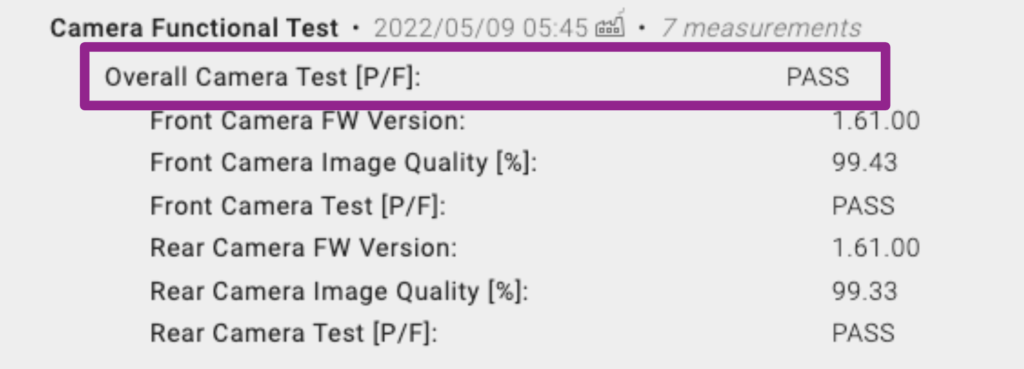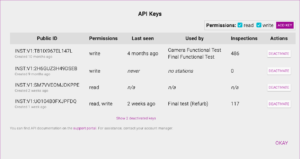Support / Quickstart Guide: Importing Functional Test Data
Who is this Quickstart Guide for?
- Anyone scoping an integrate to send test data to Instrumental
- Anyone creating their first test integration to Instrumental
Looking for full Data Streams API documentation? See this page.
TIP: Instrumental recommends you use a test project when trying your first integration. If you have not gotten access to a test environment, it’s easy to get one! Contact your Instrumental representative to get one within 24 hours.
Table of Contents
Sending Test Results
Once your account is set up and you have an API Key, you can start sending test results in minutes.
Here’s an example of a JSON body with the structure the API accepts:
{
"inspections": [
{
"serialNumber": "SN12345",
"stationName": "Camera Functional Test",
"timestamp": {
"iso8601Time": "2022-05-09T05:45:30.000Z",
"ianaTimeZone": "Asia/Shanghai"
},
"data": [
{
"name": "Overall Camera Test [P/F]",
"value": {
"string": "PASS"
}
}
]
}
]
}In the Instrumental Web App you’ll see:

See the full Data Streams API documentation page for more details.
Doing your first upload
- Log in to the Instrumental Web App
- Get an API Key by opening the API Keys modal, then clicking the purple “ADD KEY” button:


Treat all API keys like passwords and share them securely. - Upload sample data with one of these scripts, using your API key
- You can copy the minimal examples below in the language of your choice. Or, if you prefer to try parsing some data into the correct format, you can use this sample CSV:
Serial,Timestamp,Station Name,Overall Result,Battery Voltage [V],Battery Voltage Min [V],Battery Voltage Max [V],Test Suite Version RY76253,2019-10-05T07:22:10.000Z,Final Functional Test,TRUE,3.873,3.75,3.9,1.2a_DVT RY35726,2019-10-05T08:01:07.000Z,Final Functional Test,FALSE,3.992,3.75,3.9,1.2a_DVT RY73014,2019-10-05T07:23:36.000Z,Final Functional Test,TRUE,3.808,3.75,3.9,1.2a_DVT
-
Click to see cURL sample
curl -v -XPOST --data '{"inspections": [{"serialNumber": "Serial Number","stationName": "Station Name","timestamp": {"iso8601Time": "2022-04-12T18:34:40.000Z","ianaTimeZone": "Asia/Shanghai"},"data": [{"name": "Voltage (V)","value": {"double": 4.2}},{"name": "Version","value": {"string": "1.0"}}]}],"measurementLimits": {"Voltage (V)": {"in.datatypes.measurementlimit.NumberMeasurementLimit": {"passingUpperBound": 5,"passingLowerBound": 3.3}}}}' -H 'instrumental-api-key: YOUR_API_KEY' -H 'content-type: application/json' https://api.instrumental.ai/api/v1/externalData/ingest -
Click to see Python 3 sample
This example uses the requests library with Python 3. If you get a
ModuleNotFoundErrorwhen running it, runpython -m pip install requestsand try again.import json import requests response = requests.post( "https://api.instrumental.ai/api/v1/externalData/ingest", data=json.dumps({ "inspections": [ { "serialNumber": "Serial Number", "stationName": "Station Name", "timestamp": { "iso8601Time": "2022-04-12T18:34:40.000Z", "ianaTimeZone": "Asia/Shanghai" }, "data": [ { "name": "Voltage (V)", "value": {"double": 4.2} }, { "name": "Version", "value": {"string": "1.0"} } ] } ], "measurementLimits": { "Voltage (V)": { "in.datatypes.measurementlimit.NumberMeasurementLimit": { "passingUpperBound": 5, "passingLowerBound": 3.3 } } } }), headers={ "content-type": "application/json", "instrumental-api-key": YOUR_API_KEY } ) print(response) -
Click to see JavaScript sample
fetch( "https://api.instrumental.ai/api/v1/externalData/ingest", { method: "POST", headers: { "instrumental-api-key": YOUR_API_KEY, "content-type": "application/json", }, body: { "inspections": [ { "serialNumber": "Serial Number", "stationName": "Station Name", "timestamp": { "iso8601Time": "2022-04-12T18:34:40.000Z", "ianaTimeZone": "Asia/Shanghai" }, "data": [ { "name": "Voltage (V)", "value": {"double": 4.2} }, { "name": "Version", "value": {"string": "1.0"} } ] } ], "measurementLimits": { "Voltage (V)": { "in.datatypes.measurementlimit.NumberMeasurementLimit": { "passingUpperBound": 5, "passingLowerBound": 3.3 } } } } } ) .then(response => response.json()) .then(data => console.log(data));
- You can copy the minimal examples below in the language of your choice. Or, if you prefer to try parsing some data into the correct format, you can use this sample CSV:
- Check that the data shows up in the Instrumental Web App
- Start uploading your own data into the test project
- Review data with your Instrumental contact
- Start pushing data to a production project
Learn More
By following the steps above you should have uploaded test data. The next step is to parse and upload your production data. These documentation pages should be useful to you in doing that:
You may also want to bring in images and videos captured on your manufacturing line:
You may also want to export your unit data from Instrumental, including Instrumental AI results from Monitors and Measurements:

